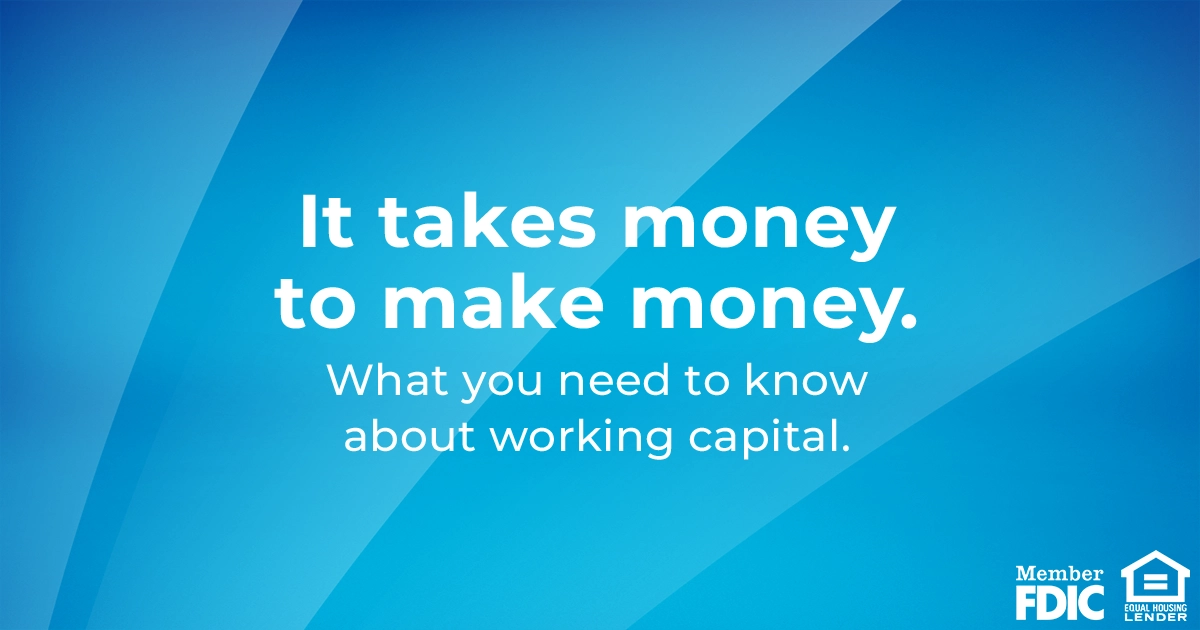
“…if it ain’t got that swing!”
One of the most common business loan requests we get as bankers is a line of credit request. While the loan structure itself isn’t that complicated, determining exactly how much is needed can be a little more complicated.
Because loan terms can be slightly different across the industry, we will consider a line of credit as any type of loan where the borrower may request disbursement of funds at some date other than the closing date. Lines can be closed-end which means that once they are drawn up once, they can’t draw that amount again. Lines can also be open-end, meaning the loan can be drawn up, paid down, and then drawn up again, similar to a credit card. From an underwriting perspective, we can delineate these two loans by the need for the money, either permanent working capital or temporary (seasonal) working capital.
Permanent working capital is something the business needs now to support itself going forward. Without permanent working capital at the required level, the business could not operate. The most common situation where an existing business needs permanent working capital is growth. And when underwriting is done right, it is easy to calculate that number with swing factors.
Swing factors are Accounts Receivable, Inventory, and Accounts Payable. And the best way to think of these is to think of each one as a lever a business may pull in order to generate or use up cash. When a business is growing, it’s easy to understand that one, if not all, of these will likely increase. But in order to understand how that will impact cash, we need to convert these balances into daily figures first. We will need to know our AR Days, Inventory Days, AP Days, and for the last step, our Sales per day.
To find our permanent working capital need, we add AR Days plus Inventory Days less AP Days. AR Days plus Inventory Days gives us how long it takes a business to make a product, sale a product, and collect the cash for the product. AP Days looks at how long we can wait before we pay cash for the supplies needed to make and sale the product. The result of that formula is usually positive number (if it’s negative, you don’t have any permanent working capital needs). So let’s craft and example where it takes us 5 days to make a product and sell it and another 45 days to collect the money from the sale. We are able to stretch our accounts payable out 30 days before we pay vendors. So 5 + 45 – 30 leaves us with 20 days. But that really doesn’t mean much when we are trying to figure out cash so we have to take the last step and determine the amount of sales per day to convert it to cash. So let’s use the example that our business averages $10,000 sales per day. We take our 20 days times $10,000 sales per day and our permanent working capital cash needs comes out to $200,000. Again, this is the amount that has to be injected into the business to continue operations.
If the business is operational and successful, we would assume that somehow and at some point, this $200,000 has already been injected into the business. But let’s say at current operations, we really don’t have any excess cash, but the business has the opportunity to land a new client that’s going to increase our sales by $5,000 per day (50% growth, who wouldn’t want that right?!?). In order to win this client, we have to stretch out their AR Days so our overall AR Days will go up 5 days to 50. Inventory days and AP days will stay the same to keep the example fairly simple. So let’s see how much additional money we need to keep the business working. Our new permanent working capital formula is now 5 + 50 – 30 or 25 days, and our new sales per day is $15,000. 25 days times $15,000 means our new permanent working capital need is $375,000 or $175,000 more than it was. That means, we will need to have $175,000 more cash invested in the bank to make the operations work. And if we anticipate this will be the new norm going forward (meaning the customer is sticking around and not just a 1 time sale), this cash will need to stay invested in the business.
For permanent working capital, it is not appropriate to have an open-end line of credit because we won’t expect it to pay down and draw back up as needed. It has to stay in the business. For this type of need, a business really should seek a closed-end line of credit that then terms out over a period of time. This will allow the business to capture the new client and then eventually support the client through equity instead of debt.
Now let’s say the business is a lawn care business and lands a new baseball field to take care of during the summer but won’t have to care for it during the off months. We can use the same approach in the swing factors to determine the level of cash needs but it will just be temporary throughout the year. In this instance, we would expect the business to draw up the line through spring and summer and eventually pay the line to zero in the fall. Given that the balance should revolve during the year, an open-end line of credit would be appropriate in this scenario.
Understanding working capital needs can help a business position itself for financial success. And while we were happy to share the advice in this article as a peek behind the veil, we don’t need you to be experts on your loan needs. If you have any questions, feel free to swing by a branch and talk with us. We are happy to find the solution that is perfect for you.


